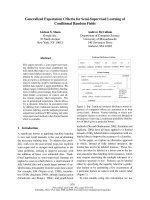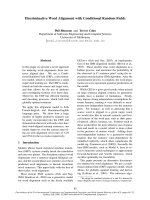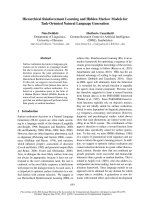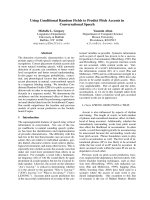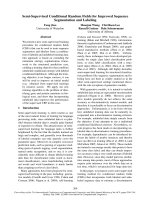conditional random fields vs. hidden markov models in a biomedical
Bạn đang xem bản rút gọn của tài liệu. Xem và tải ngay bản đầy đủ của tài liệu tại đây (128.71 KB, 5 trang )
Conditional Random Field s vs. Hidden Markov Model s
in a biomedical Named Entity Recognition t ask
Natalia Ponomareva, Paolo Rosso, Ferran Pla, Antonio Molina
Universidad Politecnica de Valencia
c/ Camino Vera s/n
Valencia, Spain
{nponomareva, prosso, fpla, amolina}@dsic.upv.es
Abstract
With a recent quick development of a molecu-
lar biology domain the Information Extraction
(IE) methods become very useful. Named Entity
Recognition (NER), that is considered to be th e
easiest task of IE, still remains very challenging
in molecular biology domain because of the com-
plex structure of biomedical entities and th e lack
of naming convention. In this paper we apply
two popular sequence labeling approaches: Hid-
den Markov Models (HMMs) and Conditional
Random Fields (CRFs) to solve this task. We ex -
ploit different stategies to construct our biomed-
ical Named Entity (NE) recognizers which take
into account special properties of each approach.
Although the CRF-based model has obtained
much better results in the F-score, the advantage
of the CRF approach remains disputable, since
the HMM-based model has achieved a greater re-
call for some biomedical classes. This fact makes
us think about a possibility of an effective com-
bination of these models.
Keywords
Biomedical Named Entity Recognition, Conditional Random
Fields, Hidden Markov Models
1 Introduction
Recently the molecular biology domain has been get-
ting a massive growth due to many discoveries that
have been made during the last years and due to a
great interest to know more about the origin, struc-
ture and functions of liv ing systems. It causes to ap-
pear every year a great deal of articles where sc ientific
groups describe their experiments and report about
their achievements.
Nowadays the largest biomedical database resource
is MEDLINE that contains more than 14 millions of
articles of the world’s biomedical journal literature and
this amount is constantly increasing - about 1,500 new
records per day [1]. To deal with such an enormous
quantity of biomedical texts different bio medical re-
sources as databases and ontologies have been created.
Actually NER is the first step to order and structure
all the existing domain information. In molecular biol-
ogy it is used to identify within the text which words
or phrases refer to biomedical entities, and then to
classify them into relevant biomedical concept classes.
Although NER in molecular biology domain has
been receiving attention by many researchers for a
decade, the task remains very challenging and the re-
sults achieved in this area are much poorer than in the
newswire one.
The principal factors that have made the biomed-
ical NER task difficult can be descr ibed as follows [11]:
(i) Different spelling forms existing for one en-
tity (e.g. “N-acetylcysteine”, “N-acetyl-cysteine”,
“NacetylCysteine”).
(ii) Very long descriptive names. For example, in
the Genia corpus (which will be described in Section
3.1) the significant part of entities has length from 1
to 7.
(iii) Term share. Sometimes two entities share the
same words that usually are headnouns (e.g. “T and
B cell lines”).
(iv) Cascaded entity problem. There exist many
cases when one entity appears inside another one (e.g.
< PROT EIN >< DNA > kappa3 < /DNA >
bindingfactor < /P R OT EIN >) that lead to certain
difficulties in a true entity identification.
(v) Abbreviations, that are widely used to shorten
entity names, create problems of its correct classifica-
tion b ecause they carry less information and appear
less times than the full forms.
This paper aims to inves tigate and compare a per-
formance of two popula r Natural Language Processing
(NLP) approaches: HMMs and CRFs in terms of their
application to the biomedical NER task. All the ex-
periments have been realized using a JNLPBA version
of Genia corpus [2].
HMMs [6] are generative models that proved to be
very successful in a variety of sequence labeling tasks
as Speech recognition, POS tagging, chunking, NER,
etc.[5, 12]. Its purpose is to maximize the joint proba-
bility of paired observation and label sequences. If, be-
sides a word, its context or another featur e s are taken
into account the problem might become intractable.
Therefore, tr aditional HMMs assume an independence
of each word from its context that is, evidently, a
rather strict supposition and it is contrary to the fact.
In spite of these shor tcomings the HMM approach of-
fers a number of advantages such as a simplicity, a
quick learning and also a global maximization of the
joint probability over the whole observation and label
sequences. The last statement means that the deci-
1
sion of the best sequence of labels is made after the
complete analysis of an input sequence.
CRFs [3] is a rather mo dern approach that has al-
ready beco me very popular for a great amount o f NLP
tasks due to its remarkable characteristics [9, 4, 8].
CRFs are indirected graphical models which belong to
the discriminative class of models. The pr incipal dif-
ference of this approach with respect to the HMM one
is that it maximizes a conditional probability of labels
given an obs e rvation s e quence. This conditional as-
sumption makes easy to represent any additional fea-
ture that a researcher could consider useful, but, at
the s ame time, it automatically gets rid of the prop-
erty of HMMs that any observation sequence may be
generated.
This paper is organized as follows. In Section 2 a
brief review of the theory of HMMs and CRFs is in-
troduced. In Section 3 different strategies of building
our HMM-based and CRF-base d models are presented.
Since corpus characteristics have a great influence on
the performance of any supervised machine-learning
model the first part of Section 3 is dedicated to a de-
scription of the corpus used in our work. In Section 4
the performances of the constructed models are com-
pared. Finally, in Section 5 we dr aw our conclusions
and discuss the future work.
2 HMMs and CRFs in sequence
labeling tasks
Let x = (x
1
x
2
x
n
) be an observation sequence of
words of length n. Let S be a se t of states of a finite
state machine each of which corresponds to a biomed-
ical entity tag t ∈ T . We denote as s = (s
1
s
2
s
n
) a
sequence of states that provides for our word sequence
x some biomedical entity annotation t = (t
1
t
2
t
n
) .
HMM-based classifier belongs to naive Bayes
classifiers which are founded on a joint probability
maximization of observation and label sequences:
P (s, x) = P (x|s)P (s)
In order to provide a tractability of the model tradi-
tional HMM makes two simplifications. First, it sup-
poses that each state s
i
only depends on a previo us
one s
i−1
. This property of stochastic sequences is also
called a Markov property. Second, it assumes that
each observatio n word x
i
only depends on the current
state s
i
. With these two assumptions the joint proba-
bility of a state sequence s with observation sequence
x can be represe nted as follows:
P (s, x) =
n
i=1
P (x
i
|s
i
)P (s
i
|s
i−1
) (1)
Therefore, the training pr ocedure is quite simple for
HMM approach, there must be evaluated thr e e prob-
ability distr ibutions:
(1) initial probabilities P
0
(s
i
) = P (s
i
|s
0
) to begin
from a state i;
(2) transition probabilities P (s
i
|s
i−1
) to pass from
a state s
i−1
to a state s
i
;
(3) observation probabilities P (x
i
|s
i
) of an appear-
ance of a word x
i
in a position s
i
.
All these probabilities may be easily c alculated using
a training corpus.
The equation (1) describes a traditional HMM
classifier of the first order. If a dependence of each
state on two proceding ones is assumed a HMM
classifier of the second order will be obtained:
P (s, x) =
n
i=1
P (x
i
|s
i
)P (s
i
|s
i−1
, s
i−2
) (2)
CRFs are undirected graphical models. Although
they are very similar to HMMs they have a different
nature. The principal distinction consists in the fact
that CRFs are discriminative models which are trained
to maximize the conditional probability of o bserva-
tion and state sequences P (s|x). This leads to a great
diminution of a number of po ssible combinations be-
tween observa tion word features and their labels and,
therefore, it makes possible to represent much addi-
tional knowledge in the model. In this approach the
conditional probability distribution is represented as a
multiplication of featur e functions exponents:
P
θ
(s|x) =
1
Z
0
exp
n
i=1
m
k=1
λ
k
f
k
(s
i−1
, s
i
, x)+
+
n
i=1
m
k=1
µ
k
g
k
(s
i
, x)
(3)
where Z
0
is a normalization factor of all state se-
quences, f
k
(s
i−1
, s
i
, x), g
k
(s
i
, x) are feature functions
and λ
k
,µ
k
are learning weights of each feature func-
tion. Although, in general, feature functions can be-
long to any family of functions, we consider the sim-
plest case of binary functions.
Comparing equations (1) and (3) there may be
seen a strong relation between HMM and CRF ap-
proaches: feature functions f
k
together with its
weights λ
k
are some analogs of transition probabil-
ities in HMMs while functions µ
k
f
k
are observation
probability analogs. But in contrast to the HMMs,
the feature functions o f CRFs may not only depend
on the word itself but on any word feature, which is
incorporated into the model. Moreover, transition fea-
ture functions may also take into account both a word
and its features as, for instance, a word context.
A training procedure of the CRF a pproach consists
in the weight evaluation in order to maximize a condi-
tional log likelihood of annotated se quences for some
training data set D = (x, t)
(1)
, (x, t)
(2)
, , (x, t)
(|D |)
L(θ) =
|D|
j=1
logP
θ
(t
(j)
|x
(j)
)
We have used CRF++ open source
1
which imple-
mented a q uasi-Newton algorithm called LBFGS for
the training procedure.
1
taku/software/CRF++/
2
3 Biomedical NE recognizers
description
Biomedical NER task consists in the detecting in a
raw text biomedical entities and assigning them to one
of the existing entity classes. In this section the two
biomedical NE recognizers, we cons tructed, ba sed on
the HMM and CRF approaches will be describe d.
3.1 JNLPBA corpus
Any supervised machine-based model depends on a
corpus that has been used to train it. The greater and
the more complete the training corpus is, the more
precise the model will be and, therefore, the better re-
sults can be achieved. At the moment the la rgest and,
therefore, the most popular biomedical annotated cor-
pus is Genia corpus v. 3.02 which contains 2,000 ab-
stracts from the MEDLINE collection annotated with
36 biomedical entity class e s. To construct our model
we have used its JNLPBA version that was applied
in the JNLPBA workshop in 2004 [2]. In Table 1 the
main characteristics of the JNLP BA training and test
corpora are illustrated.
Table 1: JNLPBA corpus characteristics
Characteristics Training Test
corpus corpus
Number of abstra c ts 2,000 404
Number of sentences 18,546 3,856
Number of words 492,551 101,039
Number of biomed. tags 109,588 19,392
Size of vocabulary 22,054 9,623
Years of publication 1990-1999 1978-200 1
The JNLPBA co rpus is annotated with 5 classes of
biomedical entities: protein, RNA, DNA, cell type and
cell line. Biomedical entities are tagged using the IOB2
notation that consists o f 2 parts: the first part indi-
cates whether the corres po nding word appears at the
beginning of an entity (tag B) or in the middle of it
(tag I); the second part refers to the biomedical entity
class the word belongs to. If the word does not belong
to any entity class it is annotated as “O”. In Fig. 1
an extract of the JNLPBA corpus is presented in or-
der to illustrate the corpus annotation. In Table 2 a
tag distribution within the corpus is shown. It can be
seen that the majority of words (about 80%) does not
belong to any biomedical category. Furthermore, the
biomedical entities themselves also have an irregular
distribution: the most frequent class (protein) con-
tains more than 10% of words, whereas the most rare
one (RNA) only 0.5% of words. The tag irregularity
may cause a confusion among different types of enti-
ties with a tendency fo r any word to be referred to the
most numerous class.
Table 2: Entity tag distribution in the training corpus
Tag
cell cell no-
name Protein DNA RNA type line entity
Tag
distr.% 11.2 5.1 0.5 3.1 2.3 77.8
Fig. 1: Example of the JNLPBA corpus annotation
3.2 Feature set
As it is rather difficult to represent in HMMs a rich
set of features and in order to be able to compare
HMM and CRF models under the same c onditions
we have not applied such commonly used features
as orthografic or morphological ones. The only ad-
ditional information we have exploited are parts-of-
sp e e ch (POS) tags.
The set of POS tags was supplied by the Genia Tag-
ger
2
. It is significant that this tagge r was trained on
the Genia corpus in order to provide better results
in the biomedical texts annotation. As it ha s been
shown by [12], the use of the POS tagger adapted to
the biomedical task may greatly improve the perfor-
mance of the NE R system than the use of the tagger
trained on any general corpus as, for instance, Penn
TreeBank.
3.3 Two different strategies to build
HMM-based and CRF-based
models
As we have already mentioned, CRFs and HMMs have
principal difference s and, therefore, distint method-
ologies s hould be employed in order to construct the
biomedical NE recog nizers based on these models.
Due to their structure, HMMs cause certain incon-
viniences for feature set representation. The simplest
way to add a new knowledge into the HMM model is to
sp e c ialize its states. This strategy was previously ap-
plied to other NLP tasks, such as POS tagging, chunk-
ing or clause detection and proved to be very effective
[5].
Thus, we have employed this methodology for the
construction of o ur HMM-based biomedical NE recog-
nizer. States specialization leads to the increasing of
a number of states and to a djusting each of them to
certain ca tegories of observations. In other words, the
idea of specialization may be formulated as a spliting
of states by means of additional features which in our
case are POS tags.
In our HMM-based system the specialization s trat-
egy using POS information serves both to provide an
additional knowledge about entity boundaries and to
diminish an entity class irreg ularity. As we have seen
2
/>3
in Section 3.1, the majority of words in the corpus does
not belong to any entity c lass. Such data irregularity
can provoke errors, which are known as false negatives,
and, therefore, may diminish the recall of the model.
It means that many biomedical entities will be clas-
sified as non-entity. Besides, there also exists a non-
uniform distribution among biomedical entity classes:
e.g. class “protein” is more than 100 times larger than
class “RNA” (see Table 2).
We have constructed three following models based
on HMMs of the second order (2):
(1) only the non-entity class has been splitted;
(2) the non-entity class and two most numerous en-
tity categories (protein and DNA) have been splitted;
(3) all the entity classes have been splitted.
It may be observed that each following model in-
cludes the set of entity tags of the previous one. Thus,
the last model has the greatest number o f states.
Besides, we have carried out various experimens
with a different number of boundary tags, and we have
concluded that only adding two tags (E - end of an en-
tity and S - a single word entity) to a standard set of
boundary tags, supplied by the JNLPBA c orpus an-
notation, can notably improve the p e rformance of the
HMM-based model.
Consequently, each entity tag of our models con-
tains the following components:
(i) entity class (pro tein, DNA, RNA, etc.);
(ii) entity bounda ry (B - beginning of an entity, I -
inside of an entity, E - end of an entity, S - a single
word entity);
(iii) POS information.
With respect to the CRF approach, the specializa-
tion strategy seems to be rather absurd, because it
was exactly developed to be able to represent a rich
set of features. Therefore, instead of increasing of the
states number the greater quantity of feature func-
tions correspo nding to each word should be used. Our
CRF-based NE recognizer along with the POS tags in-
formation employes also context features in a window
of 5 words.
4 Experiments
The standard evaluation metrics used for classification
tasks are next three measures:
(1) Recall (R) which can described as a ratio be-
tween a number of correctly recognized terms and all
the correct terms;
(2) Pr e c ision (P) that is a ratio between a number
of correctly recog nized terms and all the recognized
terms;
(3) F-score (F), introduced by [10], is a weighted
harmonic mean of recall and precision which is calcu-
lated as follows:
F
β
=
(1 + β
2
) ∗ P ∗ R
β
2
∗ P + R
(4)
where β is a weight coefficient used to control a ra-
tio between recall and precision. As a majority of re-
searchers we will exploit an unbiased version of F-score
- F
1
which esta blish an equal importance of recall and
precision.
The first ex periments we have carried out were de-
voted to compare our three HMM-based models in
order to analyze what entity class splitting provides
the best performance. In Table 3 our baseline (i.e.,
the model without class balancing procedure) is com-
pared with our three models. Although all our models
have improved the baseline, there is a significant differ-
ence between the first model and the other two models,
which have shown rather similar results.
Table 3: Comparison of the influence of different sets
of POS to the HMM-based system performance
Model
Tags Recall, Precision, F-score
number % %
Baseline 21 63.7 60.2 61.9
Model 1
40 68.4 61.4 64.7
Model 2 95 69.1 62.5 65.6
Model 3 135 69.4 62.4 65.7
In Table 4 the results we obtained with our CRF-
based system are presented. Here, the baseline model
takes into account only wor ds and their context fea-
tures. Model 1 is the final model which uses also POS-
tag information.
Table 4: The CRF-based system performance
Model Recall, % Pre c ision, % F-score
Baseline 61.9 72.2 66.7
Model 1 66.4 71.1 68.7
At first glance, if only the F-sc ore values are com-
pared, the CRF-based model outperforms the HMM-
based one with a sig nificant difference (3 points). How-
ever, when the recall and precision are compared their
opposite behaviour may be noticed : for the HMM-
based model the recall almost always is higher than
the precision where as for the CRF-based model the
contrary is true.
In Tables 5, 6 recall and precision values of the de-
tection of two biomedical entities “protein” and “cell
type” for the HMM and the CRF approaches are pre-
sented. The analysis of these tables shows the higher
effectiveness of HMMs in finding as many biomedical
entities as possible and their failure in the correctness
of this detection. CRFs are more foolproof models but,
as a result, they commit a greater error of the sec ond
order: the o mission of the correct entities.
Table 5: Recall values of a detect ion of “protein” and
“cell type” for the H MM and the CRF medels
Method
Protein cell type
HMM 73.4 67.5
CRF 69.8 60.9
4
Table 6: Precision values of a detect ion of “protein”
and “cell type” for the HMM and the CRF models
Method
Protein cell type
HMM 65.2 65.9
CRF
70.2 79.2
The certain advantag e of the CRF model with re-
sp e c t to the HMM one could also be disputed by the
fact that the best biomedical NER system [12] is prin-
cipally based on the HMMs. Neve rtheless, the com-
parison does not seem rather fair, because this sys-
tem, besides exploiting a rich set of features , employes
some deep knowledge resources and techniques such
as biomedical databases (SwissProt and LocusLink)
and a number of post-processing opera tio ns consisting
of different heuristic rules in order to correct entity
boundaries.
Summarizing the obtained re sults we can conclude
that the possibility of an effective combination of
CRFs and HMMs would be very beneficial. Since gen-
erative and discriminative models have different na-
ture, it is intuitive, that their integration might allow
to capture more information about the object under
investigation. The example of a successful combina-
tion of these methods can be a Semi-Markov CRF
approach which was developed by [7] and is a con-
ditionaly trained version of semi-Ma rkov chains. This
approach proved to obtain better results on some NER
problems than CRFs.
5 Conclusions
In this paper we have prese nted two biomedical NE
recognizer s based on the HMM and CRF approaches.
Both models have been constructed with the use of
the s ame additional infor mation in order to compar e
fairly their performance under the same conditions.
Since CRFs and HMMs belong to different families of
classifiers two dis tint strategies have b e e n applied to
incorporate an additional knowledge into these mod-
els. For the former model a methology of states spe-
cialization has been used whereas for the latter one
all a dditional information has been presented in the
feature functions of words.
The comparison of the results has shown a be tter
performance of the CRF approach if only F-scor e s of
both mo dels are compared. If also the recall and the
precision are taken into account the advantage of one
method with respect to another one does not seem so
evident. In order to improve the results, a combination
of both approaches could be very useful. As future
work we plan to apply a Semi-Markov CRF approa ch
for the biomedical NER model construction and also
investigate another possibility of the CRF-based and
the HMM-based models integration.
Acknowledgments
This work has been partially supported by MCyT
TIN2006-15265-C06-0 4 research project.
References
[1] K. B. Cohen and L. Hunter. Natural Language Processing and
Systems Biology. Springer Verlag, 2004.
[2] J. D. Kim, T. Ohta, Y. Tsuruoka, and Y. Tatei si. Intro duc-
tion to the bio-entity recognition task at jnlpba. In Proceed-
ings of the Int. Workshop on Natural Langu age Processing
in Biomedicine and its Applications (JNLPBA 2004), pages
70–75, 2004.
[3] J. Lafferty, A. McCallum, and F. Pereira. Conditional ran-
dom fields: Probabilistic models for segmenting and labeling
sequence data. In Proceedings of 18th International Confer-
ence on Machine Learning, pages 282–289, 2001.
[4] A. McCallum. Efficiently inducing features of conditional ran-
dom fields. In In Proceedings of the 19th Conference in Un-
certainty in Articifical Intelligence (UAI-2003), 2003.
[5] A. Molina and F. Pla. Shall ow parsing using sp ecialized hmms.
JMLR Special Issue on Machine Learning approaches to
Shallow Pasing, 2002.
[6] L. R. Rabiner. A tutori al on hidden markov models and se-
lected applications in speech recognition. In Proceedings of
the IEEE, volume 77(2), pages 257–285, 1998.
[7] S . Sarawagi and W. W. Cohen. Semi-markov conditional ran-
dom fields for information extraction. In In Advances in Neu-
ral Information Processing (NIPS17), 2004.
[8] B. Settles. Biomedical named entity recognition using con-
ditional random fields and novel feature sets. In Proceed-
ings of the Joint Workshop on Natural Language Processing
in Biomedicine and its Applications (JNLPBA 2004), pages
104–107, 2004.
[9] F. Sha and F. Pereira. Shallow parsing with conditional ran-
dom fields. In In Proceedings of the 2003 Human Language
Technology Conference and North American Chapter of the
Association for Computational Linguistics (HLT/NAACL-
03), 2003.
[10] J. van Rijsbergen. Information Retrieval, 2nd edition. Dept.
of Computer Science, University of Glasgow, 1979.
[11] J. Zhang, D. Shen, G. Zhou, S. Ji an, and C. L. Tan. En-
hancing hmm-based biomedical named entity recognition by
studying special phenome na. Journal of Biomedical In-
formatics (special issue on Natural Language Processing
in Biomedicine:Aims, Achievements and Challenge), 37(6),
2004.
[12] G. Zhou and J . Su . Exploring deep knowledge resources in
biomedical name recognition. In Proceedings of the Joint
Workshop on Natural Language Processing in Biomedicine
and its Applications (JNLPBA 2004), pages 96–99, 2004.
5


